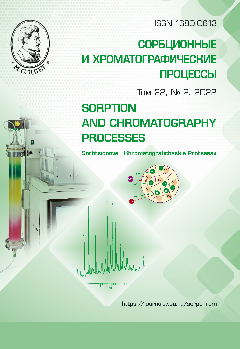Adsorption of methyl orange and alizarin red S on mesoporous titanium dioxide doped with lanthanum
Abstract
Adsorption is one of the effective methods for the purification of aqueous media from pollutants. An urgent problem is the modification and doping of the structure of TiO2, which improves its adsorption characteristics. The aim of this study was the investigation of the effect of lanthanum on the adsorption characteristics of titanium dioxide during the adsorption of methyl orange and alizarin red S.
Using the template synthesis method, samples of mesoporous titanium dioxide doped with various amounts of lanthanum were obtained – 2.2 wt.%, 9.5 wt.% and 17.9 wt.% – La(2.2)/TiO2, La(9.5)/TiO2, La(17.9)/TiO2 respectively, and a sample of undoped TiO2 was used. The obtained materials were studied using X-ray phase analysis and the low-temperature adsorption-desorption of nitrogen. The adsorption properties of the obtained titanium dioxides were studied based on the example of adsorption from aqueous solutions of methyl orange and alizarin red S.
The diffraction patterns of the synthesized samples contained only reflexes characteristic of the TiO2 phase of anatase type. It was shown that the doping of TiO2 with lanthanum led to a decrease in the size of crystallites in comparison with the size of the undoped sample. Doping the sample with lanthanum allowed increasing the specific surface area of materials from 67 m2/g for an undoped sample, up to 104-108 m2/g for doped samples. Doping with lanthanum improved the adsorption properties of the resulting doped La/TiO2 samples, compared to undoped TiO2. The best adsorption of methyl orange and alizarin red S was revealed for the La(2.2)/TiO2 sample, which is consistent with its highest pore volume compared to other samples. The adsorption of methyl orange on La(2.2)/TiO2 after 3 hours was 66%, the complete adsorption of alizarin red S from its aqueous solution occurred after 2 hours from the start of the process.
Downloads
References
Tursi A., De Vietro N., Beneduci A., Milella A., Chidichimo F., Fracassi F., Chidichimo G. Low pressure plasma func-tionalized cellulose fiber for the remediation of petroleum hydrocarbons polluted water. J. Hazard. Mater. 2019; 373: 773-782. https://doi.org/10.1016/j.jhazmat.2019.04.022
Sippel I.Y., Akhmetgaleeva G.A., Re-moval of Petroleum Products from Water Surface by Chemically Modified Wood Waste. J. Comput. Theor. Nanos. 2019; 16: 5261-5264. https://doi.org/10.1166/jctn.2019.8597
Lin Z.-J., Zheng H.-Q., Zeng Y.-N., Wang Y.-L., Chen J., Cao G.-J., Gu J.-F., Chen B. Effective and selective adsorption of organoarsenic acids from water over a Zr-based metal-organic framework. Chem. Eng. J. 2019; 378: 122196. https://doi.org/10.1016/j.cej.2019.122196
Namini A.S., Delbari S.A., Mousavi M., Ghasemi J.B. Synthesis and characteriza-tion of novel ZnO/NiCr2O4 nanocomposite for water purification by degradation of tet-racycline and phenol under visible light irra-diation. Mater. Res. Bull. 2021; 139: 111247. https://doi.org/10.1016/j.materresbull.2021.111247
Chi Y., Tian C., Li H., Zhao Y. Pol-ymerized Titanium Salts for Algae-Laden Surface Water Treatment and the Algae-Rich Sludge Recycle toward Chromium and Phe-nol Degradation from Aqueous Solution. ACS Sustainable Chem. Eng. 2019; 7: 12964-12972. https://doi.org/10.1021/acssuschemeng.9b02016
Syafrudin M., Kristanti R.A., Yuniarto A., Hadibarata T., Rhee J., Al-onazi W.A., Algarni T.S., Almarri A.H., Al-Mohaimeed A.M. J. Pesticides in Drinking Water - A Re-view. Environ. Res. Public Health. 2022; 19: 2840. https://doi.org/10.3390/ijerph.18020468
Paramasivan T., Sivarajasekar N., Mu-thusaravanan S., Subashini R., Prakashmaran J., Sivamani S., Ajmal Koya P. Graphene Family Materials for the Removal of Pesti-cides from Water. A New Generation Mate-rial Graphene: Applications in Water Tech-nology. 2018; 309-327. https://doi.org/10.1007/978-3-319-75484-0_13
Palmer M., Hatley H. The role of sur-factants in wastewater treatment: Impact, re-moval and future techniques: a critical re-view. Water Res. 2018; 147: 60-72. https://doi.org/10.1016/j.watres.2018.09.039
Ain Q.-U., Farooq M.U., Jalees M.I. J. Application of Magnetic Graphene Oxide for Water Purification: Heavy Metals Removal and Disinfection. Water Process Eng. 2020; 33: 101044. https://doi.org/10.1016/j.jwpe.2019.101044
Nayal S. Water purification: Removal of Heavy metals Using Metal-Organic Frameworks (MOFs). Metal-Organic Frameworks in Biomedical and Environmen-tal Field. 2021; 239-268. https://doi.org/10.1007/978-3-030-63380-6_7
An H.J., Bhadra B.N., Khan N.A., Jhung A.H. Adsorptive removal of wide range of pharmaceutical and personal care products from water by using metal azolate framework-6-derived porous carbon. Chem. Eng. J. 2018; 343: 447-454. https://doi.org/10.1016/j.cej.2018.03.025
Liu Y., Zhang F., Zhu W., Su D., Sang Z., Yan X., Li S., Liang J., Dou S.X. A multi-functional hierarchical porous SiO2/GO membrane for high efficiency oil/water sepa-ration and dye removal. Carbon. 2020; 160: pp. 88-97. https://doi.org/10.1016/j.carbon.2020.01.002
Wei Y., Zhu Y., Jiang Y. Photocata-lytic self-cleaning carbon nitride nanotube intercalated reduced graphene oxide mem-branes for enhanced water purification. Chem. Eng. J. 2019; 356: 915-925. https://doi.org/10.1016/j.cej.2018.09.108
Singh R.P., Singh P.K., Gupta R., Singh R.L. Treatment and Recycling of Wastewater from Textile Industry. Advances in Biological Treatment of Industrial Waste Water and their Recycling for a Sustainable Future. 2019; 225-266. https://doi.org/10.1007/978-981-13-1468-1_8
Tkaczyk A., Mitrowska K., Posyniak A. Synthetic organic dyes as contaminants of the aquatic environment and their implica-tions for ecosystems: A review. Sci. Total Environ. 2020; 717: 137222. https://doi.org/10.1016/j.scitotenv.2020.137222
Svedman C., Engfeldt M., Ma-linauskiene L. Textile Contact Dermatitis: How Fabrics Can Induce Dermatitis. Current Treatment Options in Allergy. 2019; 6: 103-111. https://doi.org/10.1007/s40521-019-0197-5
Ahrensbøll-Friis U., Simonsen A.B., Dahlin J., Isaksson M., Zachariae C., Johan-sen J.D. Allergic contact dermatitis from dyes used in the temple of spectacles. Con-tact Dermatitis, 2021; 86: 25-28. https://doi.org/10.1111/cod.13989
Jacob S.L., Cornell E., Kwa M., Funk W.E., Xu S. Cosmetics and Cancer: Adverse Event Reports Submitted to the Food and Drug Administration. JNCI Cancer Spec-trum. 2018; 2: pky012. https://doi.org/10.1093/jncics/pky012
Mathew S., Ganguly P., Kumaravel V., Harrison J., Hinder J.S., Bartlett J., Pillai S.C. Effect of chalcogens (S, Se, and Te) on the anatase phase stability and photocatalytic antimicrobial activity of TiO2. Matr. Today: Proc. 2020; 33: 2458-2464. https://doi.org/10.1016/j.matpr.2020.01.336







